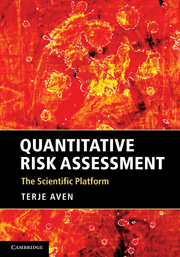Book contents
- Frontmatter
- Contents
- Preface
- Acknowledgments
- 1 Introduction to risk management and risk assessments. Challenges
- 2 Concepts and perspectives on risk
- 3 Science and scientific requirements
- 4 Introduction to case studies
- 5 Risk assessment when the objective is accurate risk estimation
- 6 Risk assessment when the objective is uncertainty descriptions
- 7 Risk management and communication issues
- 8 Towards a holistic scientific approach to risk assessment
- 9 Conclusions
- Appendix A Introduction to probability theory and statistical analysis
- Appendix B Terminology
- References
- Index
6 - Risk assessment when the objective is uncertainty descriptions
Published online by Cambridge University Press: 05 June 2012
- Frontmatter
- Contents
- Preface
- Acknowledgments
- 1 Introduction to risk management and risk assessments. Challenges
- 2 Concepts and perspectives on risk
- 3 Science and scientific requirements
- 4 Introduction to case studies
- 5 Risk assessment when the objective is accurate risk estimation
- 6 Risk assessment when the objective is uncertainty descriptions
- 7 Risk management and communication issues
- 8 Towards a holistic scientific approach to risk assessment
- 9 Conclusions
- Appendix A Introduction to probability theory and statistical analysis
- Appendix B Terminology
- References
- Index
Summary
Next we will study the scientific platform of risk assessments when the objective of these assessments is to describe uncertainties. We follow the same structure as in the previous chapter. We first summarise the framework introduced in Chapter 2 for assessing risk in such a setting, and clarify key concepts like probability and risk. We then conduct the assessments for the three cases, and from this basis we study the scientific quality of the risk assessments. Focus is again on the scientific requirements reliability and validity defined in Chapter 3. We distinguish between an (A,C,Pf)-based risk perspective (referred to as the probability of frequency approach) and an (A,C,U)-based risk perspective; in the former risk is defined through chances (which is the Bayesian term for frequentist probabilities, i.e. fractions of “successes” in the long run; refer to Chapter 2) and in the latter risk is defined through uncertainties.
Scientific basis
We consider an activity and distinguish between the following two ways of looking at risk:
Risk is defined through chances (frequentist probabilities)
Risk = (A,C,Pf), where Pf is a chance (relative frequency-interpreted probability) or a related parameter such as the expected number of occurrences of the event A per unit of time, where expectation is with respect to the chance distribution (relative frequency-interpreted probability distribution).
- Type
- Chapter
- Information
- Quantitative Risk AssessmentThe Scientific Platform, pp. 76 - 102Publisher: Cambridge University PressPrint publication year: 2011



